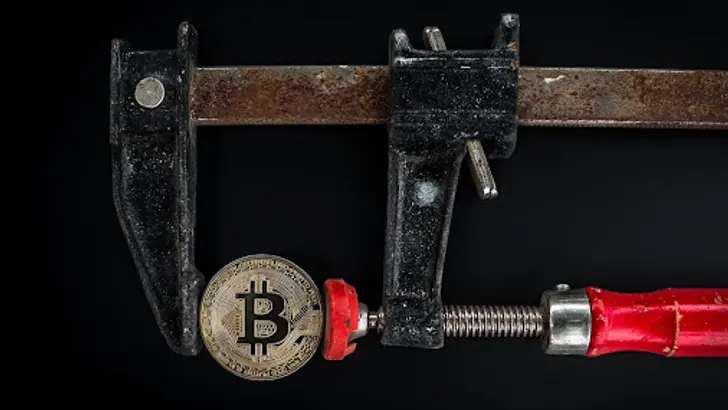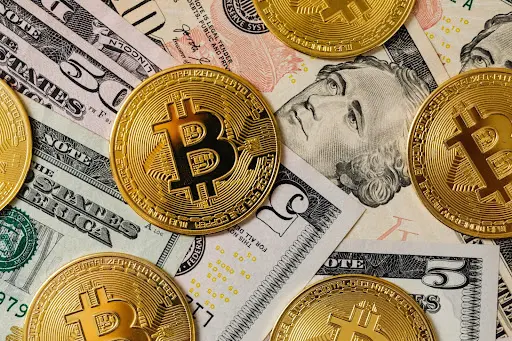How Long Does It Take to Mine 1 Bitcoin in 2023?

crypto mining
Bitcoin, the world's first decentralized digital currency, has gained widespread popularity since its creation in 2009. One of its key features is its mining process, which validates transactions on the Bitcoin network and adds them to the blockchain ledger. But how long does it take to mine 1 Bitcoin?
Mining one Bitcoin is a complex process that involves solving mathematical problems using specialized computer hardware.
Whether you are an experienced miner or just getting started, understanding the time and investment required for Bitcoin mining is essential to making informed decisions and increasing your chances of success.
If you don’t know where to start, don’t worry—this article is a great starting point! We’ll break down bitcoin mining, answer the “how long does it take to mine 1 Bitcoin” question, and more!
How Bitcoin Mining Works

Bitcoin mining is a process that enables the validation of transactions on the Bitcoin network and the addition of these validated transactions to the blockchain ledger. This process involves solving complex mathematical problems using specialized computer hardware. Miners compete to solve these problems, and the first miner to solve the problem is rewarded with newly minted bitcoins.
The process of mining is crucial to the security of the Bitcoin network. Miners are responsible for validating transactions and ensuring that the network remains decentralized. Without miners, the Bitcoin network would be vulnerable to attacks and manipulation.
Some estimates suggest that Bitcoin mining usesas much energy as a small country. To address these concerns, some miners have started using renewable energy sources to power their mining operations.
Is Mining Harder than Before?
The Bitcoin network has grown over the years, and with it, the difficulty of mining has increased. This is due to the increasing number of miners participating in the network and the limited supply of new bitcoins. The difficulty of mining is adjusted for every 2016 blocks to maintain a consistent block time of approximately 10 minutes.
The mining process becomes more difficult as the number of coins mined increases. This is because the amount of Bitcoin that can be mined is halved every 210,000 blocks, which happens approximately every four years. The next halving event is expected to occur in 2024.
One of the key features of Bitcoin is its decentralized nature. The Bitcoin network is not controlled by any central authority, and it is maintained by a network of miners and nodes.
The nodes are responsible for validating transactions and ensuring that the network remains secure. Miners, on the other hand, are responsible for adding new transactions to the blockchain ledger and are rewarded with newly minted bitcoins for their efforts.
How Long Does it Take to Mine 1 Bitcoin?

Although the theoretical time it takes to mine one Bitcoin is approximately 10 minutes, the actual time can vary significantly. This variation is due to several factors, including the mining difficulty, which is adjusted every 2016 block to maintain a consistent block time of around 10 minutes.
However, as more miners join the network and the number of mined bitcoins increases, the difficulty of mining also increases. This implies that it takes more time and energy to mine one Bitcoin.
Factors That Determine Bitcoin Mining Time
The time it takes to mine one Bitcoin is influenced by several factors, which we will discuss in detail in the following section.
#1. Hash Rate
The hash rate refers to the speed at which a miner can solve the mathematical problems required for mining. The higher the hash rate, the faster a miner can solve the problems and mine Bitcoins. A higher hash rate also means that a miner has a higher chance of being the first to validate a new block of transactions and receive the reward of newly minted Bitcoins.
#2. Mining Hardware
The mining hardware used also plays a crucial role in determining the time it takes to mine one Bitcoin. The cost of mining can be expensive, but it is essential to invest in high-quality hardware to increase the chances of successfully mining Bitcoins.
The quality of the hardware, along with other factors such as the cooling system, can also influence the mining time.
#3. Solo Mining vs. Pool Mining
Solo mining refers to mining alone, while pool mining involves joining a group of miners to mine together. Pool mining can be more efficient because it allows miners to combine their hash power, increasing their chances of successfully mining a block and earning the reward. However, pool mining also comes with a fee, which can reduce profits.
Therefore, the decision to join a mining pool or mine solo should be based on the individual's preferences and resources.
#4. Bitcoin Difficulty
The Bitcoin difficulty determines how hard it is to mine new Bitcoins. As the number of Bitcoins mined increases over time, the difficulty of mining also increases. This means that it takes more time and energy to mine one Bitcoin as the number of mined Bitcoins increases.
The difficulty is adjusted every 2016 block to maintain a consistent block time of around 10 minutes. Therefore, it is essential to monitor the difficulty level regularly and adjust the mining strategy accordingly.
#5. Additional Factors
Other factors that can affect the time it takes to mine one Bitcoin include the temperature of the mining environment, the quality of the internet connection, and the mining pool's fees. It is essential to consider all of these factors when deciding to mine Bitcoin to increase the chances of success.
Overall, the time it takes to mine one Bitcoin is influenced by various factors, and the actual time can vary significantly from the theoretical time of approximately 10 minutes. The mining difficulty and energy costs associated with mining are the primary factors that affect the time taken to mine one Bitcoin.
However, other factors, such as hash rate, mining hardware, solo mining vs. pool mining, temperature, and internet connection quality, also play a crucial role. Therefore, it is essential to have a comprehensive understanding of these factors to make informed decisions regarding Bitcoin mining.
How to Mine Bitcoin?

- Get the necessary hardware. To mine Bitcoin, you need specialized hardware, such as ASICs, that are designed specifically for this purpose.
- Get a Bitcoin wallet. You need a Bitcoin wallet to store the coins you mine. There are several types of wallets available, including hardware wallets, software wallets, and mobile wallets. Choose the one that best suits your needs.
- Join a mining pool. Pool mining allows you to combine your hash power with other miners to increase your chances of successfully mining a block and earning the reward. Choose a reputable mining pool that suits your hardware and preferences.
- Download mining software. You will need to download mining software such as CGMiner or Multiminer, connect it your hardware to the Bitcoin network, and participate in the mining process
- Start mining. Once you have set up your hardware, wallet, mining pool, and software, you can start mining Bitcoin. Keep in mind that the process can be time-consuming and energy-intensive, so be prepared for the associated costs and risks.
How Much Does it Cost to Mine Bitcoin?

Bitcoin mining can be a profitable activity, but it requires significant investment in hardware, energy, and maintenance.
In the section below, we will discuss the costs associated with mining Bitcoin and the factors that influence them.
#1. Mining Hardware
One of the significant costs associated with mining Bitcoin is the cost of mining hardware. Specialized hardware, such as ASICs, can cost thousands of dollars and require regular maintenance to function correctly.
The cost of hardware can vary depending on the quality and efficiency of the equipment. However, investing in high-quality hardware is essential to increase the chances of successful mining.
#2. Energy Costs
The energy costs associated with mining Bitcoin can also be significant, especially when traditional energy sources are used. Estimates suggest that Bitcoin mining consumes as much energy as a small country, and energy costs can make up a significant portion of the mining expenses. Miners who utilize renewable energy sources, such as solar or wind power, can reduce their costs and increase their profitability.
#4. Maintenance Costs
The maintenance costs associated with mining Bitcoin can also be significant. The hardware used for mining requires regular maintenance to function correctly, and maintenance costs can add up over time. Therefore, it is essential to consider maintenance costs when deciding to mine Bitcoin.
Bitcoin Mining Profitability
Bitcoin mining profitability depends on several factors, including the mining difficulty, Bitcoin price, and associated mining costs, such as hardware and energy. While some miners have generated significant profits, others have struggled to break even or even incurred losses.
Mining difficulty is a primary factor that determines profitability. As mining difficulty increases, it becomes more time-consuming and energy-intensive to mine new Bitcoins. Therefore, greater difficulty reduces profitability.
Bitcoin price is another factor affecting profitability. High Bitcoin prices increase mining profits. However, Bitcoin prices are volatile and can fluctuate significantly, impacting profitability.
Before deciding whether to mine Bitcoin, it is crucial to consider these factors. Some miners have generated significant profits, while others have incurred losses due to associated costs and risks. Therefore, it is essential to research and analyze thoroughly to determine potential profitability and risks before investing in Bitcoin mining.
Bitcoin mining can be profitable, but it depends on various factors such as mining difficulty, Bitcoin price, and associated mining costs. While some miners have generated significant profits, others have struggled to break even or incurred losses. Therefore, carefully consider the costs and benefits before deciding to mine Bitcoin.
How Many Bitcoins are Left to be Mined?
The Bitcoin network has a limited supply of 21 million Bitcoins, and currently, miners have mined about 18.5 million Bitcoins, leaving approximately 2.5 million BTC to be mined. However, as the number of coins mined increases, the mining process becomes more challenging.
The next halving event is expected to occur in 2024, which means that the rate at which new bitcoins are mined will continue to decrease, making it more challenging and time-consuming to mine new bitcoins.
How Many Bitcoins Can be Mined in a Day?
The theoretical limit for the number of bitcoins that can be mined per day is 1,800, which is the current block reward of 6.25 bitcoins multiplied by the 288 blocks mined every day.
However, in reality, the number of bitcoins mined per day is much lower than this theoretical limit due to the increasing difficulty of mining and associated costs. As of now, the average number of bitcoins mined per day is around 900-1,000. When deciding to mine Bitcoin, it is essential to consider these factors and have realistic expectations regarding potential profits.
Key Takeaways
Bitcoin mining is a complex and energy-intensive process that involves solving mathematical problems using specialized computer hardware. The time it takes to mine one Bitcoin is influenced by various factors, including the mining hardware used, energy costs, and mining difficulty at that time.
As the number of bitcoins mined increases, the difficulty of mining also increases, making it more challenging and time-consuming to mine new bitcoins. Therefore, it is essential to carefully consider the costs and benefits before deciding to mine Bitcoin. While some miners have generated significant profits, others have struggled to break even or even incurred losses.
However, with careful planning and investment in high-quality hardware and renewable energy sources, it is possible to mine Bitcoin profitably and contribute to the security and decentralization of the Bitcoin network.